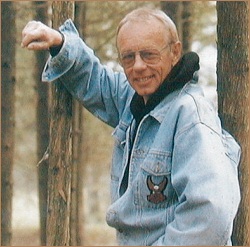 |
|
|

Freeman Patterson lives at Shamper’s Bluff, New Brunswick, near his childhood home. He holds an Honours B.A. in philosophy from Acadia University, Wolfville, Nova Scotia, and a Master of Divinity from Union Theological Seminary at Columbia University, New York. His master’s thesis was entitled Still Photography as a Medium of Religious Expression. While in New York, Freeman studied photography and visual design privately with Dr. Helen Manzer. From 1962 to 1965, Freeman was dean of religious studies at Alberta College, Edmonton, and began actively to engage in photography. He moved to Toronto in 1966 to work for one year at Berkeley Studio, the United Church of Canada still photography and film production house. During this time and until the late 1970s, Freeman completed numerous assignments for the Still Photography Division of the National Film Board of Canada. He also developed a large roster of professional clients in the editorial and advertising fields. A strong supporter of the amateur photography community, Freeman is a life member and former president of The Toronto Guild for Colour Photography. Freeman returned to New Brunswick in 1973 primarily to pursue his personal artistic interests and to establish a workshop of photography and visual design. He has taught several classes there every year and, since 1984, in southern Africa as well, where he co-founded the Namaqualand Photographic Workshops. He has given numerous workshops in the United States, Israel, New Zealand, and Australia. Since 1977, Freeman has written and illustrated four instructional books on photography and visual design, which continue to be reprinted and sell worldwide. He is the sole author and photographer for three large-format books, including a major retrospective work entitled ShadowLight: A Photographer’s Life. He has also collaborated on several other major books and written for magazines and for CBC radio. In 1985 Freeman’s love for the camera and his passion for teaching were both recognized when he was awarded membership in The Order of Canada, and also, in 2013, the Order of New Brunswick. Between 1973 and 1989, Freeman was an elected trustee of New Brunswick School District #19 and served for eight years as vice-president and director of Masterfile (a major stock photography agency), two years on the board of Aids Saint John, and six years as a trustee of the Nature Conservancy of Canada. He has donated his property on Shamper’s Bluff to the conservancy for an ecological reserve and education area. An avid motorcyclist, he is also a member of the Saint John Harley Owners’ Group. Artist's StatementEvery artist is, first of all, a craftsperson thoroughly knowledgeable about the materials, tools, and techniques of his or her particular medium and skilled in using many of them. However, in my view, no amount of technical knowledge and competence is, in and of itself, sufficient to make a craftsperson into an artist. That requires caring—passionate caring about ultimate things. As I see it, there is a close connection between art and religion in the sense that both are concerned about questions of meaning—if not about the meaning of existence in general, then certainly about the meaning of one’s individual life and how a person relates to his or her total community/environment. This is not to say that every work of art is or should be a heavily profound statement (indeed many may be light-hearted) but rather that consciously and unconsciously an artist engaged in serious work is always exploring the question: “What really matters?” For me, answering that question means recognizing the factors that produced and shaped my life. I cannot escape dealing with these things if I am to live creatively as a human being or, to put it another way, if I am to take control of and maintain the integrity of my own life. Photography (and, more generally, visual design) has been my enabling medium. In the broadest sense I photograph Nature, which includes human beings. Growing up in a rural community, I was surrounded by natural things. Unlike a child in a totally urban environment, I made friends not only with other children but also with wild and domesticated animals, plants of every sort, brooks and waterfalls, rocks and sand. I listened to the wind-chiming of ice-covered branches in winter, wandered through spring’s greening fields, splashed about for minnows in the river, and gathered bouquets of autumn leaves. However, the obviously beautiful in my environment was balanced by other realities. I saw the food chain operating, experienced the effects of droughts and floods, and daily observed the process of aging. When my little sister died, the loss I felt was assuaged by my having learned early that this happens to everyone and everything. I believe that the ability of human beings to be creative depends fundamentally on the health and well-being of our biosphere, the few kilometres of air, water, and soil that surround our planet like the skin of an apple. Quite simply, they are the physical and spiritual bases of our lives, and the only source of materials and tools that enable us to express our responses to questions and feelings about ultimate things. Creation and creativity are inextricably linked. This awareness now forms the central core of my work. The abstracting of visual elements in order to recognize their particularity has become automatic, but seeing, combining, and creating them as integrated “wholes” will remain a life-long challenge. |
Prints · Bio · CV · Books · Teaching · Honours & Awards
Originals · Bio · Collections · Exhibitions · Books
All Rights Reserved